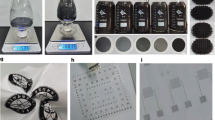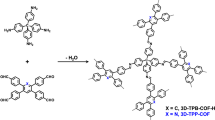Abstract
What particular mechanical properties can be expected for materials composed of interlocked backbones has been a long-standing issue in materials science since the first reports on polycatenane and polyrotaxane in the 1970s1,2,3. Here we report a three-dimensional porous metal–organic crystal, which is exceptional in that its warps and wefts are connected only by catenation. This porous crystal is composed of a tetragonal lattice and dynamically changes its geometry upon guest molecule release, uptake and exchange, and also upon temperature variation even in a low temperature range. We indented4 the crystal along its a/b axes and obtained the Young’s moduli of 1.77 ± 0.16 GPa in N,N-dimethylformamide and 1.63 ± 0.13 GPa in tetrahydrofuran, which are the lowest among those reported so far for porous metal–organic crystals5. To our surprise, hydrostatic compression showed that this elastic porous crystal was the most deformable along its c axis, where 5% contraction occurred without structural deterioration upon compression up to 0.88 GPa. The crystal structure obtained at 0.46 GPa showed that the catenated macrocycles move translationally upon contraction. We anticipate our mechanically interlocked molecule-based design to be a starting point for the development of porous materials with exotic mechanical properties. For example, squeezable porous crystals that may address an essential difficulty in realizing both high abilities of guest uptake and release are on the horizon.
This is a preview of subscription content, access via your institution
Access options
Access Nature and 54 other Nature Portfolio journals
Get Nature+, our best-value online-access subscription
$29.99 / 30 days
cancel any time
Subscribe to this journal
Receive 51 print issues and online access
$199.00 per year
only $3.90 per issue
Buy this article
- Purchase on Springer Link
- Instant access to full article PDF
Prices may be subject to local taxes which are calculated during checkout




Similar content being viewed by others
Data availability
All data are available in the Article or its Supplementary Information.
References
Agam, G., Graiver, D. & Zilkha, A. Studies on the formation of topological isomers by statistical methods. J. Am. Chem. Soc. 98, 5206–5214 (1976).
Ogata, N., Sanui, K. & Wada, J. Novel synthesis of inclusion polyamides. J. Polym. Sci. Polym. Lett. Ed. 14, 459−462 (1976).
Raymo, F. M. & Stoddart, J. F. Interlocked macromolecules. Chem. Rev. 99, 1643−1663 (1999).
Bhushan, B. & Li, X. A review of nanoindentation continuous stiffness measurement technique and its applications. Mater. Charact. 48, 11–36 (2002).
Tan, J. C. & Cheetham, A. K. Mechanical properties of hybrid inorganic–organic framework materials: establishing fundamental structure–property relationships. Chem. Soc. Rev. 40, 1059–1080 (2011).
Bruns, C. J. & Stoddart, J. F. The Nature of the Mechanical Bond: From Molecules to Machines Ch. 1 (John Wiley & Sons, 2017).
Frisch, H. L. & Wasserman, E. Chemical topology. J. Am. Chem. Soc. 83, 3789–3795 (1961).
Evans, N. H. & Beer, P. D. Progress in the synthesis and exploitation of catenanes since the millennium. Chem. Soc. Rev. 43, 4658–4683 (2014).
Gil-Ramírez, G., Leigh, D. A. & Stephens, A. J. Catenanes: fifty years of molecular links. Angew. Chem. Int. Ed. 54, 6110–6150 (2015).
Xue, M., Yang, Y., Chi, X., Yan, X. & Huang, F. Development of pseudorotaxanes and rotaxanes: from synthesis to stimuli-responsive motions to applications. Chem. Rev. 115, 7398–7501 (2015).
Sauvage, J.-P. EurJOC—50 years of rotaxanes. Eur. J. Org. Chem. 2019, 3287–3288 (2019).
Amabilino, D. B. & Stoddart, J. F. Interlocked and intertwined structures and superstructures. Chem. Rev. 95, 2725–2828 (1995).
Sauvage, J.-P. & Dietrich-Buchecker, C. Molecular Catenanes, Rotaxanes and Knots: a Journey Through the World of Molecular Topology (Wiley-VCH, 1999).
Kassem, S. et al. Artificial molecular motors. Chem. Soc. Rev. 46, 2592–2621 (2017).
Erbas-Cakmak, S., Leigh, D. A., McTernan, C. T. & Nussbaumer, A. L. Artificial molecular machines. Chem. Rev. 115, 10081–10206 (2015).
Niu, Z. & Gibson, H. W. Polycatenanes. Chem. Rev. 109, 6024–6046 (2009).
Takata, T. Polyrotaxane and polyrotaxane network: supramolecular architectures based on the concept of dynamic covalent bond chemistry. Polym. J. 38, 1–20 (2006).
Harada, A., Hashidzume, A., Yamaguchi, H. & Takashima, Y. Polymeric rotaxanes. Chem. Rev. 109, 5974–6023 (2009).
Wu, Q. et al. Poly[n]catenanes: synthesis of molecular interlocked chains. Science 358, 1434–1439 (2017).
Mena-Hernando, S. & Pérez, E. M. Mechanically interlocked materials. Rotaxanes and catenanes beyond the small molecule. Chem. Soc. Rev. 48, 5016–5032 (2019).
Qiu, Y. et al. A precise polyrotaxane synthesizer. Science 368, 1247–1253 (2020).
Okumura, Y. & Ito, K. The polyrotaxane gel: a topological gel by figure‐of‐eight cross‐links. Adv. Mater. 13, 485–487 (2001).
Choi, S., Kwon, T.-W., Coskun, A. & Choi, J. W. Highly elastic binders integrating polyrotaxanes for silicon microparticle anodes in lithium ion batteries. Science, 357, 279–283 (2017).
http://www-materials.eng.cam.ac.uk/mpsite/properties/non-IE/stiffness.html
Charitidis, C. A., Koumoulos, E. P., Nikolakis, V. & Dragatogiannis, D. A. Structural and nanomechanical properties of a zeolite membrane measured using nanoindentation. Thin Solid Films 526, 168–175 (2012).
Kitagawa, S., Kitaura, R. & Noro, S. Functional porous coordination polymers. Angew. Chem. Int. Ed. 43, 2334–2375 (2004).
Yaghi, O. M. et al. Reticular synthesis and the design of new materials. Nature 423, 705–714 (2003).
Loeb, S. J. Metal–organic rotaxane frameworks; MORFs. Chem. Commun. 1511–1518 (2005).
Li, Q. et al. A catenated strut in a catenated metal–organic framework. Angew. Chem. Int. Ed. 49, 6751–6755 (2010).
Li, Q. et al. A metal–organic framework replete with ordered donor–acceptor catenanes. Chem. Commun. 46, 380–382 (2010).
Zhao, Y.-L. et al. Rigid-strut-containing crown ethers and [2]catenanes for incorporation into metal–organic frameworks. Chem. Eur. J. 15, 13356–13380 (2009).
Vukotic, V. N., Harris, K. J., Zhu, K., Schurko, R. W. & Loeb, S. J. Metal–organic frameworks with dynamic interlocked components. Nat. Chem. 4, 456–460 (2012).
Zhu, K., Vukotic, V. N., O’Keefe, C. A., Schurko, R. W. & Loeb, S. J. Metal–organic frameworks with mechanically interlocked pillars: controlling ring dynamics in the solid-state via a reversible phase change. J. Am. Chem. Soc. 136, 7403–7409 (2014).
Zhu, K., O’Keefe, C. A., Vukotic, V. N., Schurko, R. W. & Loeb, S. J. A molecular shuttle that operates inside a metal–organic framework. Nat. Chem. 7, 514–519 (2015).
Chen, Q. et al. A redox-active bistable molecular switch mounted inside a metal–organic framework. J. Am. Chem. Soc. 138, 14242–14245 (2016).
Frank, N. C., Mercer, D. J. & Loeb, S. J. An interwoven metal-organic framework combining mechanically interlocked linkers and interpenetrated networks. Chem. Eur. J. 19, 14076–14080 (2013).
Gholami, G., Zhu, K., Ward, J. S., Kruger, P. E. & Loeb, S. J. Formation of a polythreaded, metal–organic framework utilizing an interlocked hexadentate, carboxylate linker. Eur. J. Inorg. Chem. 4524–4529 (2016).
Gholami, G., Baggi, G., Zhu, K. & Loeb, S. J. Metal–organic frameworks utilising an interlocked, hexadentate linker containing a tetra-carboxylate axle and a bis(pyridine) wheel. Dalton Trans. 46, 2462–2470 (2017).
Lewis, J. E. M. Self-templated synthesis of amide catenanes and formation of a catenane coordination polymer. Org. Biomol. Chem. 17, 2442–2447 (2019).
Johnston, A. G., Leigh, D. A., Pritchard, R. J. & Deegan, M. D. Facile synthesis and solid-state structure of a benzylic amide [2]catenane. Angew. Chem. Int. Ed. Engl. 34, 1209–1212 (1995).
Spek, A. L. Single-crystal structure validation with the program PLATON. J. Appl. Cryst. 36, 7–13 (2003).
Schneemann, A. et al. Flexible metal–organic frameworks. Chem. Soc. Rev. 43, 6062–6096 (2014).
Chui, S. S.-Y., Lo, S. M.-F., Charmant, J. P. H., Orpen, A. G. & Williams, I. D. A chemically functionalizable nanoporous material [Cu3(TMA)2(H2O)3]n. Science 283, 1148–1150 (1999).
Bundschuh, S. et al. Mechanical properties of metal–organic frameworks: an indentation study on epitaxial thin films. Appl. Phys. Lett. 101, 101910 (2012).
Henke, S., Li, W. & Cheetham, A. K. Guest-dependent mechanical anisotropy in pillared-layered soft porous crystals—a nanoindentation study. Chem. Sci. 5, 2392–2397 (2014).
Engineering ToolBox. Young’s modulus—tensile and yield strength for common materials, https://www.engineeringtoolbox.com/young-modulus-d_417.html (2003).
Boehler, R. New diamond cell for single-crystal X-ray diffraction. Rev. Sci. Instrum. 77, 115103 (2006).
Ratajczyk, P., Sobczak, S. & Katrusial, A. High-pressure structure and properties of N,N-dimethylformamide. Cryst. Growth Des. 19, 896–901 (2019).
CrystalClear v.1.3.6 (Rigaku, 2015).
CrysAlis v.40.84a (Rigaku, 2015).
Burla, M. C. et al. SIR2011: a new package for crystal structure determination and refinement. J. Appl. Cryst. 45, 357–361 (2012).
Burla, M. C. et al. IL MILIONE: a suite of computer programs for crystal structure solution of proteins. J. Appl. Cryst. 40, 609–613 (2007).
Creagh, D. C. & McAuley, W. J. in International Tables for Crystallography Vol. C (ed. Wilson, A. J. C.) 572 (Kluwer Academic, 1992).
Ibers, J. A. & Hamilton, W. C. Dispersion corrections and crystal structure refinements. Acta Crystallogr. 17, 781–782 (1964).
Creagh, D. C. & McAuley, W. J. in International Tables for Crystallography Vol. C (ed. Wilson, A. J. C.) 219–222 (Kluwer Academic, 1992).
Creagh, D. C. & Hubbell, J. H. in International Tables for Crystallography, Vol. C (ed. Wilson, A. J. C.) 200–206 (Kluwer Academic, 1992).
CrystalStructure v.4.2.5 (Rigaku, 2017).
Sheldrick, G. A. A short history of SHELX. Acta Crystallogr. A 64, 112–122 (2008).
Oliver, W. C. & Pharr, G. M. Measurement of hardness and elastic modulus by instrumented indentation: advances in understanding and refinements to methodology. J. Mater. Res. 19, 3–20 (2004).
Piermarini, G. J., Block, S. J., Barnett, D. & Forman, R. A. Calibration of the pressure dependence of the R1 ruby fluorescence line to 195 kbar. J. Appl. Phys. 46, 2774–2780 (1975).
Acknowledgements
A part of this work was conducted at the Advanced Characterization Nanotechnology Platform of the University of Tokyo, supported by ‘Nanotechnology Platform’ of the Ministry of Education, Culture, Sports, Science and Technology (MEXT), Japan. We thank K. Okitsu and K. Fukawa for technical assistance with SCXRD and PXRD, respectively; D. Hamane for discussions on high-pressure experiments; T. Uemura, N. Hosono and H. Taketomi for help with thermogravimetry/mass spectrometry measurements; S. Suginome for help with NMR spectral measurements and J.-S. M. Lee and K. Morishita for discussion on preparing the manuscript. T.A. acknowledges the Japan Society for the Promotion of Science (JSPS) for a JSPS Grant-In-Aid for Scientific Research (S) (18H05260) on ‘Innovative Functional Materials based on Multi-Scale Interfacial Molecular Science’. This work was also supported by JST, PRESTO (grant number JPMJPR20A5), Japan. H.S. is grateful for JSPS KAKENHI grant numbers 17H05357 (Coordination Asymmetry), 18H04501 (Soft Crystal) and 20H02705 (Scientific Research (B)). W.M. acknowledges the receipt of a JSPS Postdoctoral Fellowship for Research in Japan and JSPS KAKENHI grant number 20K15251.
Author information
Authors and Affiliations
Contributions
W.M., H.S. and T.A. conceived the project, designed experiments and directed the research. W.M. performed and interpreted all of the experiments associated with molecular synthesis, crystal growth and structural characterization. H.S. performed the sorption experiments. S.K., W.M. and Y.I. designed nanoindentation experiments. S.K., T.I. and W.M. conducted nanoindentation experiments. K.K., W.M. and H.S. performed high-pressure experiments. J.P. and Y.H. conducted the computational studies. All authors contributed to the writing and editing of the manuscript.
Corresponding authors
Ethics declarations
Competing interests
The authors declare no competing interests.
Additional information
Peer review information Nature thanks the anonymous reviewers for their contribution to the peer review of this work. Peer reviewer reports are available.
Publisher’s note Springer Nature remains neutral with regard to jurisdictional claims in published maps and institutional affiliations.
Supplementary information
Supplementary Information
This file contains Supplementary text, figs. 1–47, tables 1–23 and references.
Rights and permissions
About this article
Cite this article
Meng, W., Kondo, S., Ito, T. et al. An elastic metal–organic crystal with a densely catenated backbone. Nature 598, 298–303 (2021). https://doi.org/10.1038/s41586-021-03880-x
Received:
Accepted:
Published:
Issue Date:
DOI: https://doi.org/10.1038/s41586-021-03880-x
This article is cited by
-
Unconventional mechanical and thermal behaviours of MOF CALF-20
Nature Communications (2024)
-
Light-driven anisotropy of 2D metal-organic framework single crystal for repeatable optical modulation
Communications Materials (2024)
-
Elastic hydrogen-bonded ionic framework
Nano Research (2023)
-
Controlling dynamics in extended molecular frameworks
Nature Reviews Chemistry (2022)
-
Controllable photomechanical bending of metal-organic rotaxane crystals facilitated by regioselective confined-space photodimerization
Nature Communications (2022)
Comments
By submitting a comment you agree to abide by our Terms and Community Guidelines. If you find something abusive or that does not comply with our terms or guidelines please flag it as inappropriate.



